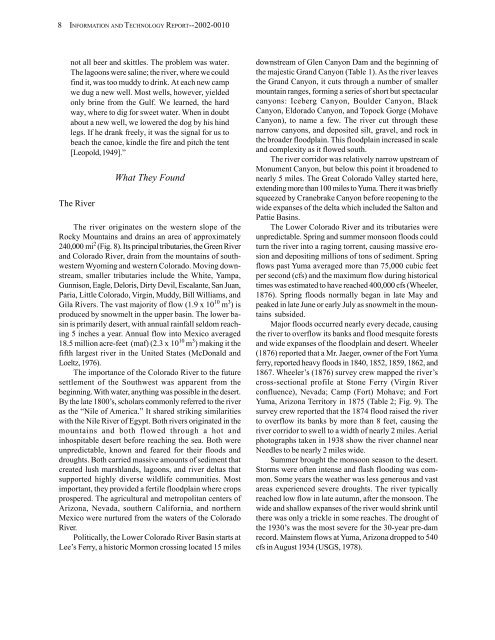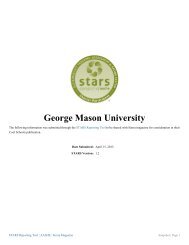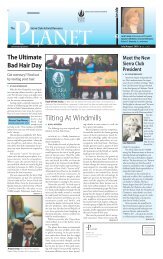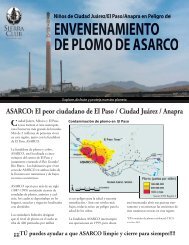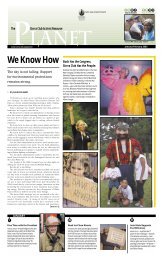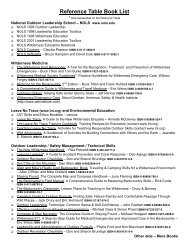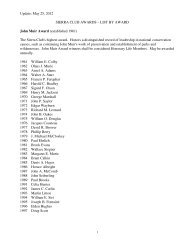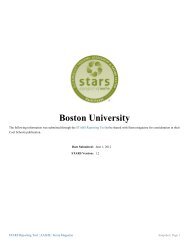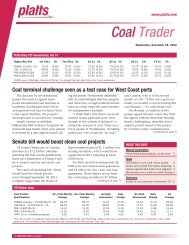Lost, A Desert River and its Native Fishes - Sierra Club
Lost, A Desert River and its Native Fishes - Sierra Club
Lost, A Desert River and its Native Fishes - Sierra Club
Create successful ePaper yourself
Turn your PDF publications into a flip-book with our unique Google optimized e-Paper software.
8 INFORMATION AND TECHNOLOGY REPORT--2002-0010<br />
not all beer <strong>and</strong> skittles. The problem was water.<br />
The lagoons were saline; the river, where we could<br />
find it, was too muddy to drink. At each new camp<br />
we dug a new well. Most wells, however, yielded<br />
only brine from the Gulf. We learned, the hard<br />
way, where to dig for sweet water. When in doubt<br />
about a new well, we lowered the dog by his hind<br />
legs. If he drank freely, it was the signal for us to<br />
beach the canoe, kindle the fire <strong>and</strong> pitch the tent<br />
[Leopold, 1949].“<br />
The <strong>River</strong><br />
What They Found<br />
The river originates on the western slope of the<br />
Rocky Mountains <strong>and</strong> drains an area of approximately<br />
240,000 mi 2 (Fig. 8). Its principal tributaries, the Green <strong>River</strong><br />
<strong>and</strong> Colorado <strong>River</strong>, drain from the mountains of southwestern<br />
Wyoming <strong>and</strong> western Colorado. Moving downstream,<br />
smaller tributaries include the White, Yampa,<br />
Gunnison, Eagle, Deloris, Dirty Devil, Escalante, San Juan,<br />
Paria, Little Colorado, Virgin, Muddy, Bill Williams, <strong>and</strong><br />
Gila <strong>River</strong>s. The vast majority of flow (1.9 x 10 10 m 3 ) is<br />
produced by snowmelt in the upper basin. The lower basin<br />
is primarily desert, with annual rainfall seldom reaching<br />
5 inches a year. Annual flow into Mexico averaged<br />
18.5 million acre-feet (maf) (2.3 x 10 10 m 3 ) making it the<br />
fifth largest river in the United States (McDonald <strong>and</strong><br />
Loeltz, 1976).<br />
The importance of the Colorado <strong>River</strong> to the future<br />
settlement of the Southwest was apparent from the<br />
beginning. With water, anything was possible in the desert.<br />
By the late 1800‘s, scholars commonly referred to the river<br />
as the —Nile of America.“ It shared striking similarities<br />
with the Nile <strong>River</strong> of Egypt. Both rivers originated in the<br />
mountains <strong>and</strong> both flowed through a hot <strong>and</strong><br />
inhospitable desert before reaching the sea. Both were<br />
unpredictable, known <strong>and</strong> feared for their floods <strong>and</strong><br />
droughts. Both carried massive amounts of sediment that<br />
created lush marshl<strong>and</strong>s, lagoons, <strong>and</strong> river deltas that<br />
supported highly diverse wildlife communities. Most<br />
important, they provided a fertile floodplain where crops<br />
prospered. The agricultural <strong>and</strong> metropolitan centers of<br />
Arizona, Nevada, southern California, <strong>and</strong> northern<br />
Mexico were nurtured from the waters of the Colorado<br />
<strong>River</strong>.<br />
Politically, the Lower Colorado <strong>River</strong> Basin starts at<br />
Lee‘s Ferry, a historic Mormon crossing located 15 miles<br />
downstream of Glen Canyon Dam <strong>and</strong> the beginning of<br />
the majestic Gr<strong>and</strong> Canyon (Table 1). As the river leaves<br />
the Gr<strong>and</strong> Canyon, it cuts through a number of smaller<br />
mountain ranges, forming a series of short but spectacular<br />
canyons: Iceberg Canyon, Boulder Canyon, Black<br />
Canyon, Eldorado Canyon, <strong>and</strong> Topock Gorge (Mohave<br />
Canyon), to name a few. The river cut through these<br />
narrow canyons, <strong>and</strong> deposited silt, gravel, <strong>and</strong> rock in<br />
the broader floodplain. This floodplain increased in scale<br />
<strong>and</strong> complexity as it flowed south.<br />
The river corridor was relatively narrow upstream of<br />
Monument Canyon, but below this point it broadened to<br />
nearly 5 miles. The Great Colorado Valley started here,<br />
extending more than 100 miles to Yuma. There it was briefly<br />
squeezed by Cranebrake Canyon before reopening to the<br />
wide expanses of the delta which included the Salton <strong>and</strong><br />
Pattie Basins.<br />
The Lower Colorado <strong>River</strong> <strong>and</strong> <strong>its</strong> tributaries were<br />
unpredictable. Spring <strong>and</strong> summer monsoon floods could<br />
turn the river into a raging torrent, causing massive erosion<br />
<strong>and</strong> depositing millions of tons of sediment. Spring<br />
flows past Yuma averaged more than 75,000 cubic feet<br />
per second (cfs) <strong>and</strong> the maximum flow during historical<br />
times was estimated to have reached 400,000 cfs (Wheeler,<br />
1876). Spring floods normally began in late May <strong>and</strong><br />
peaked in late June or early July as snowmelt in the mountains<br />
subsided.<br />
Major floods occurred nearly every decade, causing<br />
the river to overflow <strong>its</strong> banks <strong>and</strong> flood mesquite forests<br />
<strong>and</strong> wide expanses of the floodplain <strong>and</strong> desert. Wheeler<br />
(1876) reported that a Mr. Jaeger, owner of the Fort Yuma<br />
ferry, reported heavy floods in 1840, 1852, 1859, 1862, <strong>and</strong><br />
1867. Wheeler‘s (1876) survey crew mapped the river‘s<br />
cross-sectional profile at Stone Ferry (Virgin <strong>River</strong><br />
confluence), Nevada; Camp (Fort) Mohave; <strong>and</strong> Fort<br />
Yuma, Arizona Territory in 1875 (Table 2; Fig. 9). The<br />
survey crew reported that the 1874 flood raised the river<br />
to overflow <strong>its</strong> banks by more than 8 feet, causing the<br />
river corridor to swell to a width of nearly 2 miles. Aerial<br />
photographs taken in 1938 show the river channel near<br />
Needles to be nearly 2 miles wide.<br />
Summer brought the monsoon season to the desert.<br />
Storms were often intense <strong>and</strong> flash flooding was common.<br />
Some years the weather was less generous <strong>and</strong> vast<br />
areas experienced severe droughts. The river typically<br />
reached low flow in late autumn, after the monsoon. The<br />
wide <strong>and</strong> shallow expanses of the river would shrink until<br />
there was only a trickle in some reaches. The drought of<br />
the 1930‘s was the most severe for the 30-year pre-dam<br />
record. Mainstem flows at Yuma, Arizona dropped to 540<br />
cfs in August 1934 (USGS, 1978).


